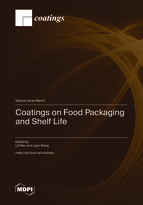Coatings on Food Packaging and Shelf Life
A special issue of Coatings (ISSN 2079-6412). This special issue belongs to the section "Coatings for Food Technology and System".
Deadline for manuscript submissions: closed (31 May 2023) | Viewed by 34630
Special Issue Editors
Interests: triple network hydrogel; polymer; food packaging; agricultural material; coatings; films
Special Issues, Collections and Topics in MDPI journals
Special Issue Information
Dear Colleagues,
Food packaging plays an important role in the preservation and transportation stages of food. In recent years, coatings packaging has become a research hotspot. Coatings can inhibit the growth of microorganisms during food storage, control gas exchange, water penetration, and oxidation processes in food, thus improving food safety and extending the shelf life of food, which brings convenience to consumers.
Food packaging plays a vital role in preserving food throughout the distribution chain. Without packaging, the processing of food can become compromised as it is contaminated by direct contact with physical, chemical, and biological contaminants. In recent years, the development of novel food packaging (modified atmosphere and active packaging) has not only increased the shelf life of foods, but also their safety and quality—therefore bringing convenience to consumers. Directly related, and interlinked, with food packaging is the concept of shelf life—the length of time that foods, beverages, pharmaceutical drugs, chemicals, and many other perishable items are given before they are considered unsuitable for sale, use, or consumption.
This Special Issue on food packaging and shelf life caters to the needs of scientists, material scientists, food chemists, and microbiologists in the area of food packaging and shelf life. The journal will mainly publish original research papers, review articles, and short communications in the following areas:
- Food packaging material development
- Coatings or films material development
- Nano coatings or films material
- Edible coatings or films
- Designing coatings or films machinery
- Physical & chemical properties of food packaging coatings or films
- Modified atmosphere packaging systems
- Active and intelligent, & antimicrobial packaging systems
- Food package testing
- Sensory properties of packaged foods
- Migration from packaging materials
- Food package interactions
- Shelf life of packaged food products
- Recycling of food packaging Materials
- Microbial stability of food during storage, handling and transportation
- Sensory changes during food storage
- Shelf life and food safety
- Chemical, physical and microbial determinants for shelf life
- Shelf life simulation
- Accelerated shelf life tests
Dr. Lili Ren
Dr. Liyan Wang
Guest Editors
Manuscript Submission Information
Manuscripts should be submitted online at www.mdpi.com by registering and logging in to this website. Once you are registered, click here to go to the submission form. Manuscripts can be submitted until the deadline. All submissions that pass pre-check are peer-reviewed. Accepted papers will be published continuously in the journal (as soon as accepted) and will be listed together on the special issue website. Research articles, review articles as well as short communications are invited. For planned papers, a title and short abstract (about 100 words) can be sent to the Editorial Office for announcement on this website.
Submitted manuscripts should not have been published previously, nor be under consideration for publication elsewhere (except conference proceedings papers). All manuscripts are thoroughly refereed through a single-blind peer-review process. A guide for authors and other relevant information for submission of manuscripts is available on the Instructions for Authors page. Coatings is an international peer-reviewed open access monthly journal published by MDPI.
Please visit the Instructions for Authors page before submitting a manuscript. The Article Processing Charge (APC) for publication in this open access journal is 2600 CHF (Swiss Francs). Submitted papers should be well formatted and use good English. Authors may use MDPI's English editing service prior to publication or during author revisions.
Keywords
- coatings
- films
- food packaging
- shelf life
- bionic surface coatings
- active packaging films







